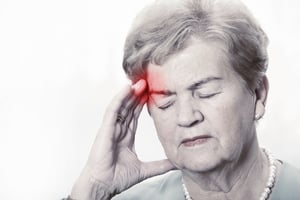
Respiratory acidosis is a condition that occurs when then lungs do not remove enough of the carbon dioxide (CO2) that is produced by the body.
Normal lung function takes in oxygen from the air, and removes carbon dioxide during exhalation, exchanging the gases in the alveoli in the lungs.
When the lungs do not remove all of the carbon dioxide, excess CO2 occurs in the body.
Excess CO2 can cause the pH level in the blood (as well as other fluids in the body) to decrease, resulting in a higher acidity level.
Normal levels of pH in the blood range between 7.35 and 7.45, but when the acidity level rises, the pH level will fall below 7.35 (the lower the pH scale number (from 0 to 14), the more acidic it is).
Our body does have a few tricks up its sleeve when it comes to balancing pH levels, one major trick is balancing the ions that control acidity in the body.
By balancing this level, if something is only slightly off, our bodies can adjust without causing any serious conditions.
When respiratory acidosis occurs, it is often because of an underlying disease or condition that is reducing the amount of CO2 being exhaled and increasing the amount being inhaled.
If respiratory acidosis occurs because of an underlying disease or condition, it is also called respiratory or ventilatory failure.
Some underlying diseases and conditions that can cause respiratory acidosis are:
- Asthma
- COPD
- Pneumonia
- Sleep apnea
Types of Respiratory Acidosis:
Acute Respiratory Acidosis: this form of respiratory acidosis can occur very quickly and is considered a medical emergency. If no medical treatment is sought, it can become life-threatening as the symptoms only progress.
Chronic Respiratory Acidosis: this form of respiratory acidosis develops over time, and often doesn’t cause any symptoms. The body often adapts to manage the increased acidity. Developing a disease or condition can cause the chronic respiratory acidosis to turn into acute respiratory acidosis.
Symptoms of Acute Respiratory Acidosis:
- Headache
- Anxiety
- Blurred vision
- Restlessness
- Confusion
Symptoms Without Treatment:
- Fatigue
- Low energy
- Confusion
- Shortness of breath
- Coma
Symptoms of Chronic Respiratory Acidosis:
Though there is often no, or minimal symptoms, chronic respiratory acidosis may still present some noticeable symptoms.
- Memory loss
- Sleep disturbances
- Personality changes
Causes of Respiratory Acidosis:
The lungs and the kidneys are the two organs in our bodies that help regulate blood pH levels.
Lungs remove acidity by exhaling the carbon dioxide and taking in oxygen, while the kidneys help remove acid through urine.
Respiratory acidosis often occurs when a disease or condition that affects breathing or impairs the lungs’ ability to remove carbon dioxide.
Common causes of chronic respiratory acidosis are asthma, COPD, acute pulmonary edema, severe obesity, neuromuscular disorders and scoliosis.
These diseases and conditions most often cause respiratory acidosis but is often not noticed or is not life-threatening.
Common causes of acute respiratory acidosis are asthma, COPD, emphysema, pneumonia, conditions that can affect the rate of breathing, muscle weakness affecting the ability to breathe, obstructed airways, sedative overdose and cardiac arrest.
These diseases and conditions can produce a much worse outcome, as it can cause acute respiratory acidosis.
Diagnosis of Respiratory Acidosis:
When a doctor suspects respiratory acidosis, most tests to diagnose the disease focus on pH imbalance.
Tests such as blood gas measurements, electrolytes, lung function tests, chest x-rays, urinalysis and other tests.
Blood Gas Measurement: This test (or a series of tests) measures oxygen and carbon dioxide levels in the blood. Blood is often drawn from an artery and then tested for levels of oxygen and CO2 to determine high or low the level of acidity is.
Electrolytes: Testing for electrolytes measure the amount of sodium, potassium, chloride and bicarbonate in the blood. Blood will be drawn, most often in conjunction with other tests.
Lung Function Tests: Multiple tests are under the term lung function tests, such as spirometry and lung volume tests. These tests measure the amount of air that the lungs as well as how much air the lungs can hold.
Chest X-rays: X-rays can help see any abnormalities or lack thereof, in the lungs (which can help determine the cause of your symptoms) as well as see any injuries or possible causes of respiratory acidosis.
Urinalysis: A urinalysis test your urine for any abnormal levels of many different chemicals and components found in the urine. It can help detect a urinary tract infection, kidney disease, diabetes and high or low levels of acidity in the urine.
Treatment:
There are multiple ways to treat respiratory acidosis, and it all depends on the form and other condition you may have.
Acute Respiratory Acidosis Treatment: When treating acute respiratory acidosis, it normally focuses on the cause on it. It often requires immediate treatment in order to prevent any further damage or health risks.
Chronic Respiratory Acidosis Treatment: For those with chronic respiratory acidosis, the treatment focuses on any underlying conditions. The most important thing is to prevent any further damage and improve lung damage.
Medications such as antibiotics, diuretics, bronchodilators, corticosteroids and mechanical ventilation.
Antibiotics: These may be prescribed when there is an infection causing the respiratory acidosis.
Diuretics: These are prescribed when there is excess fluid built up around the heart and lungs, as this helps remove that fluid, making it easier to breathe.
Bronchodilators: For those with COPD, these may be prescribed to treat their underlying condition, help relieve any stress on the airways and expand the airways.
Corticosteroids: When inflammation occurs around the lungs and in the chest, corticosteroids may be prescribed to help reduce that inflammation.
Mechanical Ventilation: If acute respiratory acidosis gets very severe (even life-threatening), mechanical ventilation may be used to prevent the condition from worsen while medical professionals determine a cause.
Outlook of Respiratory Acidosis:
The outlook of either form of respiratory acidosis depends on the cause of the condition and the individual.
For many underlying conditions, there are treatments to help live a long and healthy life after diagnosis and to reduce respiratory acidosis (if not fully stopped).
As for acute respiratory acidosis, if it is not caught it time, it can have life-long effects, if not end in death.
Otherwise, medical professionals should be able to give you a diagnosis and an outlook for your overall health.
Prevention of Respiratory Acidosis:
If you have not been diagnosed with any respiratory diseases or conditions (i.e. asthma, COPD) it is important to maintain your lung health.
Those who smoke are at a higher risk of developing respiratory acidosis, so quitting smoking is very important to prevent a respiratory disease or condition.
Weight can also play a factor in your ability to breathe, so maintaining a healthy weight can help reduce the possibility of developing a respiratory disease or condition.
If you have been diagnosed with a respiratory disease or condition, managing and monitoring these diseases/conditions can help prevent respiratory acidosis.
Conclusion:
Respiratory acidosis can become very serious, if not fatal if it is not caught in time.
As the acidity in your blood increases, it can cause damage to the organs in your body.
Respiratory acidosis often occurs when the lungs are not removing enough carbon dioxide and it stays in the body.
If you notice any symptoms, contact your doctor immediately or call 911 if your symptoms are severe.



